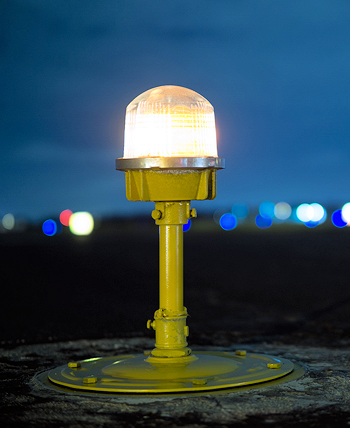Subscriber question:
"The other night I was in the landing flare and the runway lights went off without warning. I turned them back on right away by keying the mic, but I don’t want this to ever happen again. What can I do? " — Jan L.
Jeff:
 “The airport lights should stay on for at least 15 minutes after activation from the air. That’s enough for most airplanes to turn them on while still 10 miles out and have time to arrive, land, and taxi in before the lights turn off. If you’re flying an Aeronca Champ into a headwind, well, they might time out on you.
“The airport lights should stay on for at least 15 minutes after activation from the air. That’s enough for most airplanes to turn them on while still 10 miles out and have time to arrive, land, and taxi in before the lights turn off. If you’re flying an Aeronca Champ into a headwind, well, they might time out on you.
More common is arriving in the pattern to find them on because someone before you activated them. Then you start your downwind with only a minute left on the timer and … the rest is fate.
A good habit, whether you turned on the lights yourself or found them on, is to reset the timer while on downwind. I suggest keying the mic enough to reduce the brightness of the lights. Usually, that’s 5 clicks of the mic for medium intensity or 3 clicks for low. This is helpful both because they won’t time out, and because you probably don’t need (or want) full brightness just to land VFR. Lower lights can also help your night vision for seeing other potential hazards, like animals. If you’re doing night pattern work, reset the lights after every few downwinds. If you’re shooting an instrument approach, make a habit of turning them up to full intensity (usually 7 clicks) after you cross the final approach fix inbound. Be prepared to turn them back down a bit if you break out into excellent visibility.
Of course, the flip side of this is you’re on short final with the lights on low—and someone else keys their mic 7 times. The light blinds you for a moment at the worst time. Therefore, listen on the CTAF for a bit before turning on the runway lights.
With the advent of LEDs, some runways have the lights on all the time, so all you can do is change the brightness. LED airplane lights also mean our landing lights don’t fail nearly as often as they used to. Even so, I think it’s worth practicing landings without a landing light. I even think it’s worth practicing with all cabin lights and instruments that don’t have internal backup batteries turned off, to simulate a complete electrical failure at night. Comfort landing without the landing light can be handy. On misty evenings, or with a bright moon, you might actually see better with runway lights on but your landing light off.
You might also consider practicing exactly what happened to you: Landing with no runway lights. Sometimes, the remote activation just doesn’t work, and other factors dissuade you from landing elsewhere. Just make sure you have a good landing light and know that there’s an increased risk of not seeing objects or the remaining runway distance.”
Do you ever practice landing at night with the landing light off or the runway lights off? (One or the other, but not both off.)

